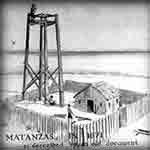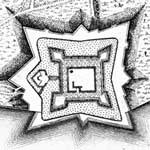
The flag which flies over Fort Matanzas and the Castillo de San Marcos is described in heraldry as a red saltire raguly on a white field. A saltire is an X figure; raguly refers to the jagged edges of the cross. The X-shaped cross is commonly called "St. Andrew's cross" because tradition says that Andrew the Disciple was crucified on a cross shaped like an X. 
Drawing by Albert Manucy Early Watchtowers As early as 1569 the Spanish recognized the vulnerability of the Matanzas Inlet and built a wooden watchtower and a thatched hut to house six soldiers who took turns scanning the horizon. If a ship was sighted, a runner or small boat set out to warn St. Augustine. Watching and warning were the tower's tasks for it lacked any armament. At least twice the watchtower kept pirates from coming in this "backdoor". In 1683 English outlaws captured the watchtower, but word made it to St. Augustine, and ships and soldiers came and drove them off. In 1686 French pirates attempted to come into the inlet, but again word was sent to St. Augustine, and these pirates, too, were repulsed. In Florida's warm, wet climate, these wooden watchtowers often had to be rebuilt or replaced. No sign of any of the towers remain, but archaeological evidence suggests that they may have been on Anastasia Island in the vicinity of the park's visitor center.
_1.jpg?maxwidth=650&autorotate=false)
NPS Photograph The British Threat After the French, the British became the main threat. Beginning with Sir Francis Drake's raid on St. Augustine in 1586, during which he burned the town, England repeatedly harassed the Spanish colony. Charles Towne (Charleston) in the Carolina Colony was established by the English in 1670. The English colony of Georgia was founded in 1733 by General James Oglethorpe. Both of these colonies were on land claimed by Spain. Hostilities were inevitable, and the British leaders were looking for an excuse for attacking St. Augustine. Wars in Europe gave them the excuse to carry the hostilities to the new world. Read More . . .

The Building of the Castillo "Today, Sunday, about four in the afternoon, the second of October 1672 . . Manuel de Cendoya, Governor and Captain General of these provinces for Her Majesty. . . with spade in hand. . . began the foundation trenches for the construction of the Castillo." Thus did the government notary attest the official ground breaking for the Castillo de San Marcos, St. Augustine's most enduring legacy of the First Spanish Period and a tribute to the craftsmanship and skill of the engineers, artisans and labourers who built it.
|
Last updated: June 24, 2017
